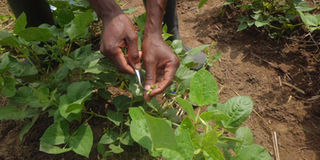Improving green gram, pigeonpea and cowpea varieties to perform better

Cowpea varieties that are undergoing trials at the research institute in Serere. Photo by Lominda Afedraru
What you need to know:
The legumes are bred for pest and disease resistance and drought tolerance, which are constraints to increased production.
The green gram (Vigna radiata), commonly known as Mungbean and Choroko, is cultivated mainly in the eastern and northern parts of Uganda. However, while there are few local varieties of the crop, which originates from Asia, the few improved varieties such as K26 are imported.
It is one of the legumes being bred at National Semi Arid Resources Research Institute (NaSARRI) in Serere to develop varieties adapted to the local situation, less prone to shuttering as well tolerant to drought.
The scientists, who are also breeding the varieties for resistance against or tolerance to pest and diseases, are using cross pollination.
They pick a male flower from a variety, which is less susceptible to drought and matures faster, and cross with a female flower of a different variety. This is in a bid to come up with better varieties, which is as high yielding under harsh climatic conditions.
Mr Emmanuel Mbeyagala, the breeder in charge of legumes, explained that his team picks an open flower and dusts its pollen to the female bud in a greenhouse setting. The same process is being applied to cow pea (Vigna unguiculata) and pigeon pea.
Head of the grain-legume programme at NaSARRI, Mr Robert Amayo, added that the research work is also focusing on enhancing the agronomic practices and incorporation of farmer-preferred attributes.
Good performance
He explained that there are now early- and medium-duration pigeon pea varieties: SEPI1, which matures in four-and-a-half months and yields up to 1,300kg per hectare, while SEPI2 matures within four months and yields up to 1,500kg per hectare. Both varieties are widely adapted and intercrop well with cereals such as sorghum, millet and maize.
Cow pea is the other crop being improved, which can be used both for food and animal feed.
Some newly released varieties are SECOW 3B, which contains black seeds and matures within 72-74 days, with a yield of up to 2,500kg per hectare under good management; SECOW 4W, which contains white seeds, has tasty leaves and grains, and yields up to 2,300kg per hectare; and SECOW5T, which has brown/tan seeds, and yields up to 2,500 kg per hectare. The other varieties released earlier include SECOW1T and SECOW 2W.
All the improved varieties are products of crosses of elite lines with local varieties, which perform well nationally and mature within three months.
Exciting development
Agronomic technologies developed include intercropping, spacing, fertiliser application, early planting, and pest spraying all of which are crafted to the specific varieties.
According to Amayo, his team was excited to see green grams flowering and even bearing fruits, during the recent dry conditions. This meant the improvement of this particular crop is succeeding.
“When carrying out the crossing of this particular crop, we are looking at the varieties that grow fast to avoid exceeding the growth period into dry periods. We realised the pods of these varieties are a little heavier with bigger seeds and they are easy to pick during harvest,” he said.
Apart from addressing challenges of drought and long maturity periods, the team is also addressing pests and disease. The green gram is commonly attacked by Cercospora leaf spot, which causes drying of the leaves. But with the improved varieties, the farmers have better output.
Modern methods
Cercospora leaf spot also affects pigeon pea as well as the Fusarium wilt disease and cow pea is commonly affected by the aphid born virus.
The pests include folia pests, which eat up the leaves, beetles, fire flies, pod borers and flower insects, which farmers tend to ignore yet they are a major cause of flower abortion.
Mr Robert Omadi, a senior technician in the grain-legume programme, said the major challenge is using the conventional method, which takes about six to seven years to come up with the required variety.
“During the crossing, we are looking at the outcome and this takes about six to seven generations to come up with a stable variety. When we come up with the farmer-preferred varieties, we multiply the breeder seeds, which we give to seed companies for further multiplication to be accessed by farmers. However, it would be recommendable to use modern biotechnology for breeding but we lack equipped laboratories to carry out this research,” he elaborated




